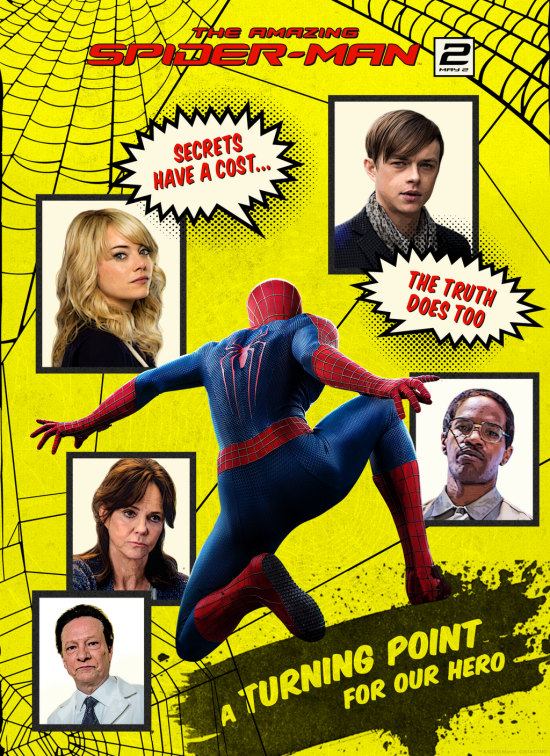The Amazing Spider-Man 2's Shock Ending: A Comics to Screen Comparison
Warning: Spoilers ahead for The Amazing Spider-Man 2, in theaters now.Those who have been reading [...]

Warning: Spoilers ahead for The Amazing Spider-Man 2, in theaters now.
Those who have been reading comic books decided pretty early on that we knew how The Amazing Spider-Man 2 was going to play out. Back in 1973, writer Gerry Conway, artist Gil Kane and inkers John Romita Sr. and Tony Mortellaro wrote a two-part story arc in which they teased a "turning point" for Spider-Man. "Someone close to me is going to DIE!" Spider-Man helpfully narrated on the cover to the first issue (The Amazing Spider-Man #121). As it turned out, they delivered...and that story serves as the inspiration for the most-discussed aspect of the new movie.

The story's second part was titled "The Night Gwen Stacy Died," which was also the title that would be assigned to the two-part tale in future collections and reprints. It leaves very little ambiguity as to just how the story wraps up (although it also saw the death of Norman Osborn's Green Goblin, and given the nature of comic book death in the seventies versus now, he stayed that way for a bit). In the tale, The Green Goblin (Norman) abducts Gwen and lures Spider-Man to a tower of either the Brooklyn Bridge (as depicted in the art) or the George Washington Bridge (as given in the text). Goblin tosses her off the bridge and Spider-Man, in trying to save her, shoots a web around her legs. When he brings her up, she's dead. There's been some question over the years as to whether it was the whiplash effect of the way she was saved that broke her neck (there's a controversial "snap" sound effect that appears in some versions of the story but not in all) or whether she was already dead when Goblin tossed her away. Since he was impaled by his glider before there was an opportunity to interrogate him, there would be no definitive way for the characters to know. In The Amazing Spider-Man #125, Marvel Comics editor Roy Thomas wrote in the letters column that "it saddens us to have to say that the whiplash effect she underwent when Spidey's webbing stopped her so suddenly was, in fact, what killed her. In short, it was impossible for Peter to save her. He couldn't have swung down in time; the action he did take resulted in her death; if he had done nothing, she still would certainly have perished. There was no way out."

The way it was done was fairly straightforward, and that contributed to Peter's feelings of guilt and impotence. Over the years, it's been established that he has played the death of Gwen Stacy over and over again in his head, obsessing about whether he could have done anything to save her. He did manage to save Mary Jane Watson in a live-action film version of basically the the same scene in 2002. Holding up a tram car full of innocent people with one hand and Mary Jane in the other, Goblin forces Peter to choose who to save. Ultimately, the scene is set up for Peter to save both, and that's what he does, averting any sense of tragedy from the scene. Arguably, the use of this setup is what made it necessary for The Amazing Spider-Man 2 to make a number of changes to the actual death scene.

In the comics, the question of whether he could have saved Gwen was also resolved in the text. When the villain Chameleon, depressed and reaching out for help, pretended to have taken Mary Jane hostage at the top of the bridge, Spider-Man ultimately used every trick he'd thought of in the time since Gwen died to try and save a suicidal Chameleon. It was to no avail, though, and as you see at right, Chameleon went under. The helplessness at the core of the story is one of the only things that was kept; in The Amazing Spider-Man 2, Gwen dies when a battle between Spider-Man and Green Goblin sees her fall from the inside of a clock tower after the gears in the tower sever one of Spider-Man's lines which had been keeping her safe. Spider-Man dives after her, firing off a web that manages to catch her -- too late. Again, it's not totally clear whether she died from the whiplash or from her head hitting the ground (it's really, really close and there's a pretty significant smack/snap noise either way) -- we'll have to wait for Blu-ray so that we can freeze-frame it, and/or listen to the filmmaker commentary to see whether they intended it to be ambiguous or whether there's a particular answer. Many fans have speculated that because of the long fall, whiplash is a more likely scenario, snapping her spine, since the only blood in the sequence is a trickle from Gwen's nose. Goblin doesn't die, either -- or, rather, Norman Osborn does die, but he isn't Green Goblin in this story and his son Harry is seen at the end of the film collaborating with The Gentleman to assemble the Sinister Six.

One thing worth mentioning -- she does wear the same outfit in the movie (or very close, anyway) that she did in "The Night Gwen Stacy Died." Early in filming, somebody saw stars Andrew Garfield and Emma Stone filming near the bridge and her wearing that green-and-white jacket...and all of us started writing stories like this one in our head.
0comments